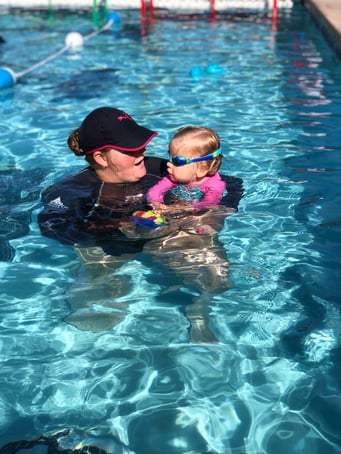For some parents, nap time can be the most difficult time of the day. There are many different factors that may be contributing to the reason that your toddler may be resistant to their nap. Napping is essential to a toddler’s growth process because taking a nap provides crucial downtime in between stimulation. Toddlers also can very quickly become over-tired, much like adults, the only difference being that most toddlers will display their exhaustion through tantrums and outbursts. Keeping a toddler on a consistent nap schedule is overall beneficial to their development and well-being. Some helpful tips in maintaining a consistent nap schedule for your child are listed below.
.jpg?width=324&name=IMG_0536%20(edited-Pixlr).jpg)
The most obvious reason for a child to become tired and want to sleep is exertion. Having your child burn off energy before nap time is the single most effective way for them to go down for a nap. One great activity to engage your child in is swim lessons. During swim lessons, children are both exerting energy and stimulating their brain through the learning process that comes along with a lesson. This dual exertion is likely to tucker your kiddo out. At Premier Aquatics, our swim lessons are thirty minutes long and include both learning and playtime. Other activities to engage your child in include open gym, playtime at the park, soccer, dance class, and any other activity where they are challenged both physically and mentally.

Another way to boost the opportunity for nap time is to limit screen time in the hour leading up to nap time. Many studies have been done to show that too much screen time can not only result in inconsistent sleep schedules, but is also linked to behavioral and attention deficit problems in children. Certain media can be very educational for children, but is important to use screen time in moderation and pay particular attention to limiting it in the hours of the day leading up to both napping and night-time sleep.
Trying your best to maintain a consistent daily routine is another great way to help aide your child in going down for a nap. Children adapt best to set schedules, so it is beneficial to schedule activities at the same time daily. For example, if your child does swim lessons every Tuesday and Thursday at 11:00 AM, go home and have lunch, then take a nap at 1:00, their mind and body will adjust to this and it will become routine nature. Changing the daily schedule and having inconsistency in nap time alters the mind and therefore may present struggle falling asleep.

With the above tips, your child should start to adapt better to their nap schedules. Try to designate the bedroom/bed/crib to both nap time and night-time sleep, that way your child can associate sleep to one specific location. Use positive reinforcements when it comes to nap time and make sure that your child is surrounded by a calming and peaceful nap environment. Remember to visit our website if you are interested in using swim lessons as an awesome pre-nap energy burning activity for your toddler.